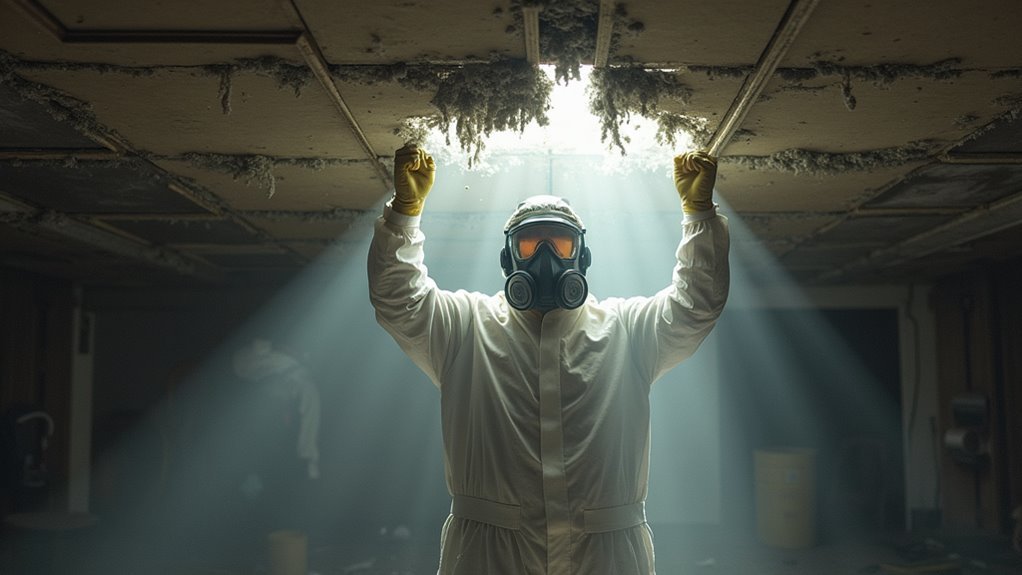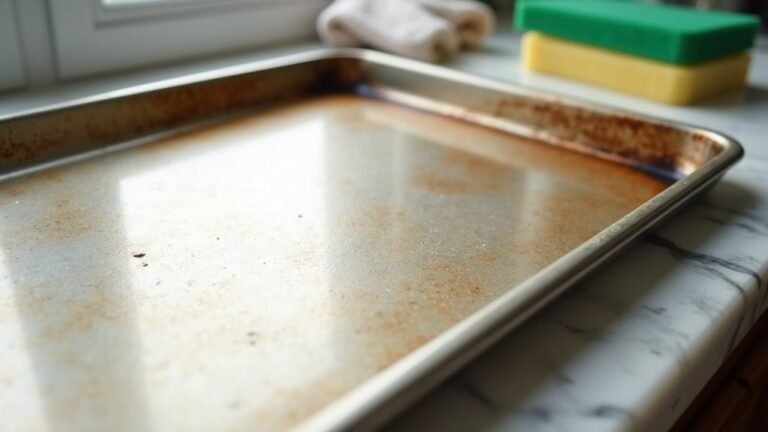Asbestos cleanup isn’t a do-it-yourself job – it’s a serious health risk that needs special care. When disturbed, asbestos breaks into tiny fibers that can float in the air and harm our lungs. What many people don’t realize is that trying to clean it up without proper training can actually make things more dangerous.
According to the Environmental Protection Agency (EPA), “If asbestos-containing material is more than slightly damaged, or if you are going to make changes in your home that might disturb it, repair or removal by a trained and accredited asbestos professional is needed.”
The safest approach is to:
- Don’t touch or disturb any material you think might contain asbestos
- Keep everyone away from the area
- Don’t sweep, vacuum, or dust suspected asbestos materials
- Contact a licensed asbestos removal expert right away
- Don’t try to remove it yourself, even if it seems simple
Remember, asbestos can be found in old floor tiles, ceiling materials, pipe insulation, and even some old appliances. If your home was built before 1980, it’s best to have a professional check any suspicious materials before starting any home projects or repairs.
Asbestos Kills Silently

Why don’t we talk about one of the most frightening aspects of asbestos?
It kills silently over decades.
What’s truly terrifying is that exposure today mightn’t show symptoms for 20 to 50 years.
##
We’ve covered how dangerous asbestos can be, and now we need to talk about what actually goes into cleaning it up safely.
Let’s look at both the essential steps to take when dealing with asbestos and the critical mistakes you’ll want to avoid to protect yourself and others.
I think understanding these basics might literally save your life, or at least prevent serious health complications down the road.
Things to Do When Cleaning Asbestos
Cleaning up asbestos requires stringent safety measures to prevent dangerous fiber release that can lead to serious health conditions like mesothelioma and asbestosis.
The process demands careful preparation, proper equipment, and strict adherence to disposal regulations to minimize health risks for everyone involved.
- Thoroughly wet all asbestos materials with a fine water spray before beginning cleanup to prevent fibers from becoming airborne.
- Seal off the work area completely with 6-mil plastic sheeting and maintain negative air pressure to contain any released fibers.
- Wear proper personal protective equipment including N-100 or P-100 respirators, disposable coveralls, gloves, and goggles.
- Use only HEPA-filtered vacuums for initial cleaning as standard vacuums will spread dangerous fibers throughout the air.
- Follow up vacuum cleaning with wet methods using damp mops, rags, or sponges to capture remaining particles.
- Double-bag all asbestos waste in clearly labeled 6-mil plastic bags marked “ASBESTOS WASTE” and fill only halfway to prevent tears.
- Dispose of all waste materials at EPA-authorized disposal sites in accordance with local regulations.
- Clean all tools and equipment thoroughly before removing them from the contained work area.
Things to Avoid When Cleaning Asbestos
When dealing with asbestos cleanup, taking proper precautions is absolutely critical to prevent serious health risks and legal consequences.
Asbestos fibers, once disturbed, can remain airborne for days and penetrate deep into lung tissue when inhaled, potentially leading to life-threatening conditions like mesothelioma, lung cancer, and asbestosis.
These diseases often develop decades after exposure, making prevention the only effective protection.
- Regular vacuum cleaners – Standard vacuums lack HEPA filtration and will simply redistribute asbestos fibers into the air, greatly increasing exposure risk.
- Sweeping or dusting – These actions aerosolize invisible asbestos fibers, creating a dangerous cloud that can be inhaled and carried throughout your home.
- Cutting, drilling, or sanding – These aggressive methods release thousands of fibers per square inch, creating an extreme hazard that can contaminate an entire building.
- Working without proper protection – Failing to use N-100 or P-100 respirators and complete protective gear leaves you directly exposed to carcinogenic fibers.
- DIY removal or cleanup – Attempting to handle asbestos without professional expertise violates regulations, risks your health, and can result in hefty fines exceeding $30,000.
Steps
Cleaning up asbestos is a hazardous task that requires strict adherence to safety protocols to prevent dangerous fiber exposure.
Proper asbestos cleanup involves careful preparation, appropriate personal protective equipment, controlled removal techniques, and proper disposal methods.
Following established regulatory guidelines not only guarantees your safety but also protects others from potential exposure to harmful asbestos fibers that can cause serious respiratory diseases including mesothelioma and asbestosis.
Step 1: Seal off the work area completely with heavy plastic sheeting, creating negative air pressure with HEPA-filtered exhaust fans, and post appropriate warning signs to prevent unauthorized entry.
Step 2: Put on proper personal protective equipment including N-100 or P-100 respirators, disposable coveralls, gloves, and eye protection before entering the containment area.
Step 3: Thoroughly wet all asbestos-containing materials with a fine water spray mixed with a wetting agent to suppress fiber release during handling.
Step 4: Carefully remove wetted asbestos materials without breaking, cutting, or damaging them to minimize fiber release.
Step 5: Place removed materials directly into specially designed 0.2 mm thick polythene bags, filling them only halfway, then seal and place inside a second bag (double-bagging).
Step 6: Seal bags securely with adhesive tape and clearly label them as asbestos waste according to regulatory requirements.
Step 7: Clean the entire work area using wet cleaning methods and HEPA vacuums, never using standard vacuum cleaners which can disperse fibers.
Step 8: Perform a thorough visual inspection to ensure all visible dust and debris has been removed from the work area.
Step 9: Transport sealed waste packages to an EPA-authorized disposal facility as soon as possible following completion of work.
Step 10: Conduct air quality testing to verify fiber levels are within acceptable limits before removing containment barriers and reopening the area.
Final Thoughts
Maneuvering the complex world of asbestos cleanup demands our utmost attention to safety and regulatory compliance.
We can’t stress enough that professional handling is worth the investment—remember, diseases may develop decades after exposure.
While recycling options are emerging, prevention remains our best strategy.
Whether you choose removal or encapsulation, always prioritize health over cost.
The peace of mind from proper abatement is, we think, truly priceless.
##

Cleaning up asbestos is a serious matter that requires proper precautions and techniques to guarantee safety.
Remember the key elements of proper asbestos cleanup: using HEPA-filtered equipment rather than standard vacuums, thoroughly wetting surfaces to prevent fibers from becoming airborne, leaving complex cleanup to trained professionals who understand OSHA regulations, properly double-bagging all waste materials, and conducting air quality testing afterward to confirm the area is safe.
The stakes are high when dealing with asbestos—exposure can lead to life-threatening conditions that may not manifest for decades.
This isn’t simply about regulatory compliance; it’s about protecting yourself, your family, and anyone who may enter the space in the future.
If you suspect asbestos in your home or workplace, don’t hesitate to contact certified professionals.
The investment in proper cleanup procedures is insignificant compared to the potential health consequences of improper handling.
Take asbestos seriously, follow these guidelines, and prioritize safety above convenience or cost at every step of the removal process.






